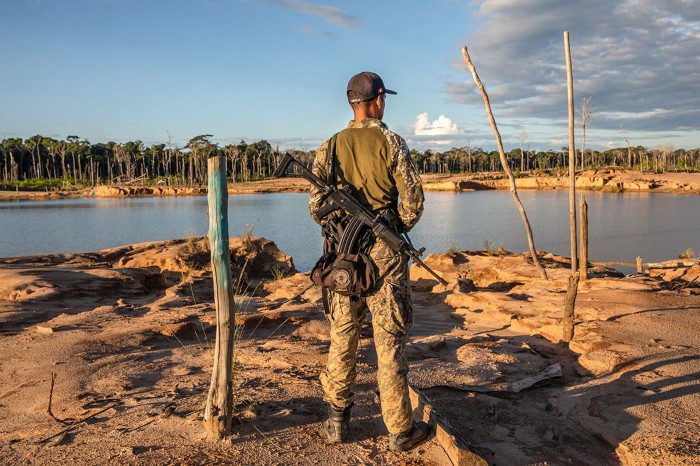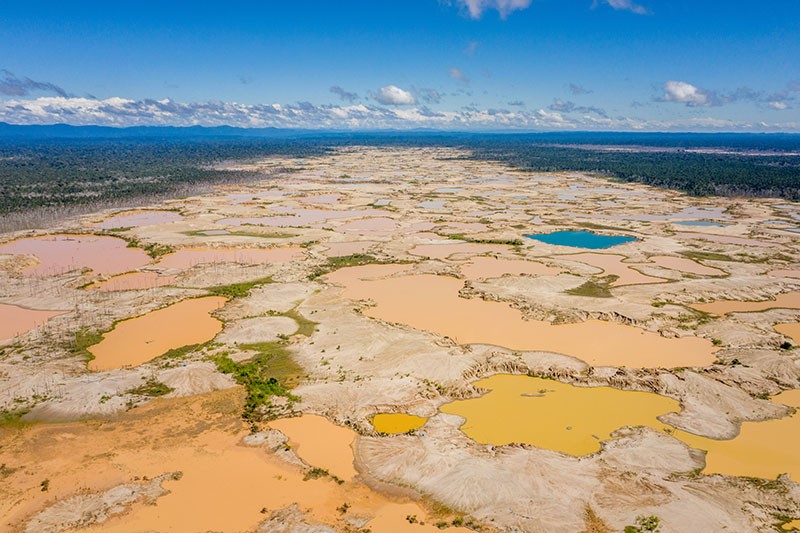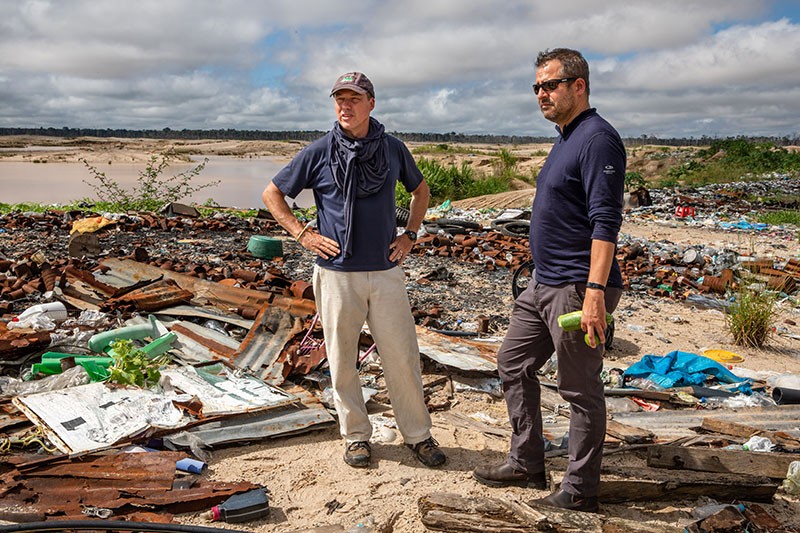Jeff Tollefson
Search for this author in:

A soldier patrols La Pampa, an area in Peru that was once lush rainforest. Credit: Brett Gundlock for Nature
La Pampa, Peru
“Holy shit!” Miles Silman gasped as his motorized rickshaw rattled out of the forest and onto a desolate beach. All traces of the trees, vines and swamps that once covered this patch of the Amazon had vanished. In their place were sun-baked dunes and polluted ponds created by illegal gold-mining. Silman, a conservation biologist at Wake Forest University in Winston-Salem, North Carolina, was there to document the carnage.
La Pampa was once the largest and most dangerous gold-mining zone in the Peruvian Amazon, so riddled with gangsters that scientists dared not enter. For nearly a decade, they could only watch by satellite as gold hunters mowed down some of the most biodiverse rainforest on the planet. That ended in February 2019, when the government declared martial law and expelled an estimated 5,000 miners.
Now, La Pampa is deserted and under military guard. When Silman and his colleagues surveyed the area for the first time in late June, they found a barren, eerily quiet landscape polluted with mercury, a toxic by-product of mining. The data that the researchers collect on this inadvertent experiment could help to determine the extent to which restoration is possible — or document the evolution of an entirely new, and human-made, ecosystem.
Silman and his colleagues at the Center for Amazonian Science and Innovation (CINCIA), a non-profit research institute in Puerto Maldonado, Peru, has spent the past several months mapping the area with drones and surveying the remaining plants and animals. The team has been studying dozens of tree species to see which ones can survive among the dunes and along the shores of ponds.
CINCIA scientists have also tested the air, water and soil for mercury contamination. Another team, from Duke University in Durham, North Carolina, has collected data there to help unravel how mercury — which can harm children’s brain development — moves from polluted water or soil and up the food chain.
The research by the CINCIA team and other scientists will feed into the Peruvian government’s ongoing efforts to rehabilitate the area, says Camila Alva, director of pollution control and chemical substances at the country’s environment ministry.
The government has already begun a pilot project to restore the Tambopata National Reserve, a protected forest that miners invaded as La Pampa expanded. Peruvian president Martín Vizcarra visited the reserve on 5 December in a show of support. Results from that work could help to guide the government’s longer-term efforts to reforest, and perhaps even resettle, parts of La Pampa.
Follow the gold
La Pampa started out as a roadside outpost on the Interoceanic Highway, one of the first stops for would-be miners who flowed from the Andes into the Madre de Dios region of the Peruvian Amazon when gold prices spiked a decade ago. The regional capital, Puerto Maldonado, grew into a mining hub. And La Pampa became a bustling town of some 25,000 people with a reputation for prostitution, modern-day slavery and organized crime.
The boom proved too lucrative to control. The gold dust is almost everywhere, and with a few rudimentary devices — including a petrol-powered water pump and a hand-made sluice — anyone can collect silt. Then it’s just a matter of mixing in mercury, which binds the gold, to recover as much as 10–15 grams of gold per day. That is several hundred dollars’ worth on the global market.
Miners don’t worry about the metal’s inevitable release into the environment or the health effects of mercury exposure, says Luis Fernandez, CINCIA’s executive director. “It’s easy,” he says. “I can teach you to do it in 15–20 minutes, and you don’t have to worry about dying — immediately.”
But researchers want to understand how much mercury miners left behind, and how it is moving through the ecosystem. On a sunny June day in La Pampa, the CINCIA team explored the site in preparation for research that will look for mercury contamination in the air, water and soil, as well as birds, fish and other aquatic life. At the first stop, environmental chemist Claudia Vega parted with the group and walked down to the shore of a small pond. Two rusty fuel drums were partially buried in the bank.
“We have birds and insects, that’s something that we can sample,” said Vega, who coordinates CINCIA’s mercury research programme. “I haven’t seen any fish.” The tests will help scientists to determine how much mercury could be moving into the food chain, where it would pose a danger to people, including the farmers who have laid down claims for land in La Pampa.
So far, testing by CINCIA and others suggests that the mercury contamination is concentrated in the ponds. That means the land is probably safe for farming, but that eating fish that live in the ponds could be dangerous. “We cannot put people out there — families and children — if we don’t know what the risk is,” says Martin Arana, a forest engineer who is advising the Peruvian forest service.
Level terrain
The team is also measuring the extent of deforestation in La Pampa and the potential to reforest the area. During their first trip, in June, , the researchers launchedtheir first drone flight on a dune deep inside the mining zone. After an obligatory photograph with the Peruvian soldiers who escorted the research team into La Pampa, the fixed-wing aircraft lifted off.
The drone flew north-south transects at a height of around 200 metres to produce detailed 3D maps of the area’s topography, including its dunes and ponds. Silman’s team is using those maps to estimate how much carbon was released into the atmosphere when the forest was mowed down to make way for mining activities. That information can also be used to track forest recovery and guide future plant surveys.
Government officials are assessing the cost and technical feasibility of a major reforestation effort — as well as the jobs that it might produce. Working with CINCIA, Peru’s park service and environment ministry have already launched their pilot reforestation project on 30 hectares of the Tambopata National Reserve. The agencies are planning to replicate that work across more than 750 hectares in the reserve.
The forest service is also studying how to design, implement and pay for an even larger reforestation project in La Pampa which could begin in a few years. But Arana says that the government will have to remain vigilant to the threat of illegal mining. “What happens if the price of gold is very, very high?” he asks. “Maybe the illegal miners come back to La Pampa, and there will be conflict with the people who are working in reforestation.”
Silman is interested in understanding how different types of vegetation will recolonize the landscape naturally — and whether people might be able to guide and accelerate the process of reforestation. Strangler fig trees, which typically start life high in tree tops where light is abundant and then strangle their hosts, are already sprouting up in La Pampa’s dunes, alongside burrowing owls (Athene cunicularia) that typically nest in arid shrublands.
Silman’s team has been growing test plots of more than 75 plant species to guide the reforestation push. The scientists are tracking how the plants perform in a variety of conditions; some prefer flat terrain with direct sun, whereas others need shade or very moist soil. The team’s results suggest that adding charcoal — or a similar substance called biochar1 — to the soil bolsters plant growth and survival. “We want to give people options, so that we aren’t just planting trees that are going to die,” Silman says.
Miners stripped the region’s soils of all of their nutrients and fundamentally changed the way water moves through the landscape. That will make restoration attempts in La Pampa more difficult than in other areas where people have rebuilt or restored ecosystems harmed by mining, says Stuart Pimm, an ecologist at Duke University in Durham, North Carolina.
But rather than worrying too much about trying to recreate what was there before, Pimm says that scientists and the government should get some plants in the ground and let nature take its course. “Just getting some forest cover is something they can probably do,” he says, “and it’s going to be a hell of a lot better than a barren landscape with some toxic puddles in the middle.”
As Silman and his colleagues wrapped up their day of field work in June, the Sun was setting — and La Pampa was coming alive. Ducks were on the move, and fish in ponds began rising to feed on insects. Silman has little doubt that plants and animals will recolonize this largely empty space over hundreds or thousands of years. The question, he says, is whether scientists can help to accelerate that recovery, or whether La Pampa will remain little more than a monument to human stupidity over the coming decades.
“That land has already been deforested,” he says. “There’s a lot of incentive for us to be clever and to try to do good things there.”
References
Source: Ecology - nature.com







